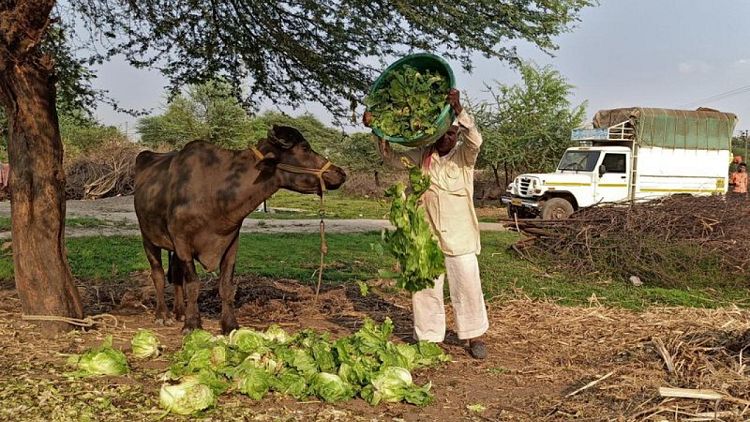By Rajendra Jadhav and Swati Bhat
Satara, INDIA - Having watched his father's funeral pyre burn by a river bank close to their farm last month, Indian sugarcane grower Dattatray Bagal and his brothers had to set aside grief to count the financial cost of the coronavirus's impact on their family.
They had hoped to buy a tractor for the small farm in western Maharashtra state, but the brothers spent all their savings on hospital treatment for their father and three other family members who survived. "The hospital bill was 820,000 rupees ($11,191). It not only exhausted our savings but also forced us to borrow from relatives," Bagal said as he irrigated the fields in the farm below the mountains of the Western Ghats.
"We lost our father and incurred debt as well. We will repay the debt in two to three years, but the personal loss can never be compensated," said Bagal, who also caught the virus when it ripped through his family.
Such accounts have become commonplace among rural communities in the vast Indian hinterland in the wake of a devastating second wave of infections that peaked in the past two months.
Lockdowns imposed by authorities trying to contain the surge added to the pain, but at least the monsoon season, which began this month, is forecast to deliver normal rainfall.
Some farmers like Yogesh Patil from Sangli district of Maharashtra were hit so badly that they don't have money to buy seeds and fertilizers to plant summer-sown crops such as corn and soybean.
"I was expecting to earn more than 100,000 rupees from a one-acre plot of tomatoes. But prices crashed because of the lockdown and I couldn't recover the production cost," Patil told Reuters.
Almost two-thirds of India's 1.35 billion population live in the small towns and villages in the countryside, and the rural economy accounts for about a third of the country's gross domestic product.
So whatever bounce back India's economy makes from the pandemic, the farm sector is unlikely to be a big help, with rural households saddled in debt, unable to make purchases needed to drive their farm output, or keep money circulating in their communities.
Rural India was largely spared during the first wave of infections, which peaked in September, as the farm sector grew 3.6% in the fiscal year that ended in March, even though latest official estimates showed the broader economy contracted 7.3%. But the second wave appears to have washed away that resilience.
"This time sentiments in the hinterland are very weak and even those with money are choosing to save rather than spending it or paying off loans," said Ramesh Iyer, managing director, Mahindra Finance, one of the biggest shadow lenders in the rural sector.
Iyer said even with farm incomes rising, fewer people are taking on housing, car and personal loans, and nearly one in three borrowers are delaying repayments. This is either because lockdowns have restricted activity or people's earnings have stopped or they prefer to save for emergencies.
Mahindra & Mahindra, India's biggest tractor maker, sold 22,843 tractors in May, down 12.6% from April for its worst month this year. Graphic: India tractor sales falling in 2021: https://graphics.reuters.com/INDIA-ECONOMY/RURAL/jbyprgyrzve/chart.png
VACCINATION SLOWER IN RURAL AREAS
The spread of coronavirus to the countryside exposed the paucity of the medical infrastructure, and the impact of the epidemic is still being assessed, with little trust in official figures on infections and deaths as testing for the disease has been woefully inadequate.
India's vaccination drive is also far behind the curve, and the fears of a potential third wave are damaging people's confidence in the economic outlook.
"There are serious concerns over rural demand and businesses," said Rupa Rege Nitsure, chief economist with L&T Financial Management, adding that a lot depended on how fast India vaccinates its rural towns and villages.
Rating agency ICRA continues to expect a prolonged negative impact of the second wave on consumer sentiment and demand, with healthcare and fuel expenses eating into disposable income, and less pent-up demand in 2021/22 relative to last year.
Rising input costs, notably for fuel, have eroded the benefits reaped by farmers from improved prices for their produce in the last six months.
"We hire tractor for ploughing, sowing and to bring fertilizers," said Gajanan Patil, a farmer from Maharashtra. "As diesel prices have hit a record high, ploughing charges have also gone up by 30%. Even to harvest crop and to carry it to markets we will have to pay more."
($1 = 73.2725 Indian rupees)
